Murine gammaherpesvirus 68 evades host cytokine production via replication transactivator-induced RelA degradation
- PMID: 22130545
- PMCID: PMC3302405
- DOI: 10.1128/JVI.06127-11
Murine gammaherpesvirus 68 evades host cytokine production via replication transactivator-induced RelA degradation
Abstract
Cytokines play crucial roles in curtailing the propagation and spread of pathogens within the host. As obligate pathogens, gammaherpesviruses have evolved a plethora of mechanisms to evade host immune responses. We have previously shown that murine gammaherpesvirus 68 (γHV68) induces the degradation of RelA, an essential subunit of the transcriptionally active NF-κB dimer, to evade cytokine production. Here, we report that the immediately early gene product of γHV68, replication transactivator (RTA), functions as a ubiquitin E3 ligase to promote RelA degradation and abrogate cytokine production. A targeted genomic screen identified that RTA, out of 24 candidates, induces RelA degradation and abolishes NF-κB activation. Biochemical analyses indicated that RTA interacts with RelA and promotes RelA ubiquitination, thereby facilitating RelA degradation. Mutations within a conserved cysteine/histidine-rich, putative E3 ligase domain impaired the ability of RTA to induce RelA ubiquitination and degradation. Moreover, infection by recombinant γHV68 carrying mutations that diminish the E3 ligase activity of RTA resulted in more robust NF-κB activation and cytokine induction than did infection by wild-type γHV68. These findings support the conclusion that γHV68 subverts early NF-κB activation and cytokine production through RTA-induced RelA degradation, uncovering a key function of RTA that antagonizes the intrinsic cytokine production during gammaherpesvirus infection.
Figures

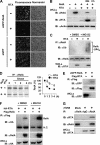

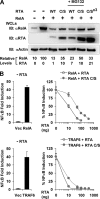
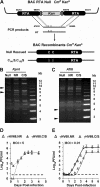
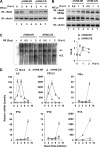
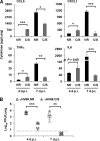
Similar articles
-
Murine gamma herpesvirus 68 hijacks MAVS and IKKβ to abrogate NFκB activation and antiviral cytokine production.PLoS Pathog. 2011 Nov;7(11):e1002336. doi: 10.1371/journal.ppat.1002336. Epub 2011 Nov 10. PLoS Pathog. 2011. PMID: 22110409 Free PMC article.
-
Dissecting host-virus interaction in lytic replication of a model herpesvirus.J Vis Exp. 2011 Oct 7;(56):3140. doi: 10.3791/3140. J Vis Exp. 2011. PMID: 22006158 Free PMC article.
-
A critical Sp1 element in the rhesus rhadinovirus (RRV) Rta promoter confers high-level activity that correlates with cellular permissivity for viral replication.Virology. 2014 Jan 5;448:196-209. doi: 10.1016/j.virol.2013.10.013. Epub 2013 Oct 29. Virology. 2014. PMID: 24314650 Free PMC article.
-
Dissecting innate immune signaling in viral evasion of cytokine production.J Vis Exp. 2014 Mar 2;(85):51078. doi: 10.3791/51078. J Vis Exp. 2014. PMID: 24637875 Free PMC article.
-
The Rta/Orf50 transactivator proteins of the gamma-herpesviridae.Curr Top Microbiol Immunol. 2007;312:71-100. doi: 10.1007/978-3-540-34344-8_3. Curr Top Microbiol Immunol. 2007. PMID: 17089794 Review.
Cited by
-
IKKα-Mediated Noncanonical NF-κB Signaling Is Required To Support Murine Gammaherpesvirus 68 Latency In Vivo.J Virol. 2022 May 25;96(10):e0002722. doi: 10.1128/jvi.00027-22. Epub 2022 Apr 28. J Virol. 2022. PMID: 35481781 Free PMC article.
-
The replication and transcription activator of murine gammaherpesvirus 68 cooperatively enhances cytokine-activated, STAT3-mediated gene expression.J Biol Chem. 2017 Sep 29;292(39):16257-16266. doi: 10.1074/jbc.M117.786970. Epub 2017 Aug 15. J Biol Chem. 2017. PMID: 28821622 Free PMC article.
-
KSHV RTA Induces Degradation of the Host Transcription Repressor ID2 To Promote the Viral Lytic Cycle.J Virol. 2022 Jun 22;96(12):e0010122. doi: 10.1128/jvi.00101-22. Epub 2022 May 23. J Virol. 2022. PMID: 35604218 Free PMC article.
-
NF-κB activation coordinated by IKKβ and IKKε enables latent infection of Kaposi's sarcoma-associated herpesvirus.J Virol. 2014 Jan;88(1):444-55. doi: 10.1128/JVI.01716-13. Epub 2013 Oct 23. J Virol. 2014. PMID: 24155403 Free PMC article.
-
Emerging Roles of Protein Deamidation in Innate Immune Signaling.J Virol. 2016 Apr 14;90(9):4262-4268. doi: 10.1128/JVI.01980-15. Print 2016 May. J Virol. 2016. PMID: 26889032 Free PMC article. Review.
References
-
- Akira S, Uematsu S, Takeuchi O. 2006. Pathogen recognition and innate immunity. Cell 124:783–801 - PubMed
-
- Ben-Neriah Y, Karin M. 2011. Inflammation meets cancer, with NF-kappaB as the matchmaker. Nat. Immunol. 12:715–723 - PubMed
-
- Borst EM, Crnkovic-Mertens I, Messerle M. 2004. Cloning of beta-herpesvirus genomes as bacterial artificial chromosomes. Methods Mol. Biol. 256:221–239 - PubMed
-
- Carbone A, Cesarman E, Spina M, Gloghini A, Schulz TF. 2009. HIV-associated lymphomas and gamma-herpesviruses. Blood 113:1213–1224 - PubMed
Publication types
MeSH terms
Substances
Grants and funding
LinkOut - more resources
Full Text Sources
Other Literature Sources
Research Materials

